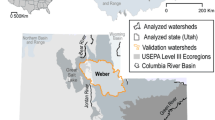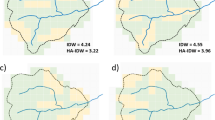Abstract
Efforts to quantify the effects of riparian buffers on watershed nutrient discharges have been confounded by a commonly used analysis, which estimates buffer potential as the percentage of forest or wetland within a fixed distance of streams. Effective landscape metrics must instead be developed based on a clear conceptual model and quantified at the appropriate spatial scale. We develop new metrics for riparian buffers in two stages of increasing functional specificity to ask: (1) Which riparian metrics are more distinct from measures of whole watershed land cover? (2) Do functional riparian metrics provide different information than fixed-distance metrics? (3) How do these patterns vary within and among different physiographic settings? Using publicly available geographic data, we studied 503 watersheds in four different physiographic provinces of the Chesapeake Bay Drainage. In addition to traditional fixed-distance measures, we calculated mean buffer width, gap frequency, and measures of variation in buffer width using both “unconstrained” metrics and “flow-path” metrics constrained by surface topography. There were distinct patterns of relationship between watershed and near-stream land cover in each physiographic province and strong correlations with watershed land cover confounded fixed-distance metrics. Flow-path metrics were more independent of watershed land cover than either fixed-distance or unconstrained measures, but both functional metrics provided greater detail, interpretability, and flexibility than the fixed-distance approach. Potential applications of the new metrics include exploring the potential for land cover patterns to influence water quality, accounting for buffers in statistical nutrient models, quantifying spatial patterns for process-based modeling, and targeting management actions such as buffer restoration.
Similar content being viewed by others
References
Altman SJ, Parizek RR (1995) Dilution of nonpoint-source nitrate in groundwater. J Environ Qual 24:707–718
Baker ME, Wiley MJ, Seelbach PW (2001) GIS-based hydrologic modeling of riparian areas: implications for stream water quality. J Am Water Resour Assoc 37(6):1615–1628
Baker ME, Wiley MJ, Seelbach PW, Carlson ML (2003) A GIS-based index of groundwater potential for aquatic resource inventory, assessment, and environmental management. Environ Manage 32:706–719
ME Baker DE Weller TE Jordan (2006) ArticleTitleComparison of automated watershed delineations: effects on land cover areas, percentages, and relationships to nutrient discharge Photogram Eng Remote Sens 72 IssueID2 159–168
Baker ME, Weller DE, Jordan TE (in review). Effects of stream map resolution on patterns of riparian buffers and nutrient retention potential. Landscape Ecol
Cooper AB (1990) Nitrate depletion in the riparian zone and stream channel of a small headwater stream. Hydrobiologia 202:13–26
Correll DL, Jordan TE, Weller DE (1997) Failure of agricultural riparian buffers to protect surface waters from groundwater nitrate contamination. In: Gibert J, Mathieu J, Fournier F (eds) Groundwater/surface water ecotones: biological and hydrological interactions and management options. Cambridge University Press, Cambridge, UK, pp 162–165
Cullinan VI, Thomas JM (1992) A comparison of quantitative methods for examining landscape pattern and scale. Landscape Ecol 7:211–227
SE Gergel (2005) ArticleTitleLandscape indicators of water quality: can simple spatial theory guide their development? Landscape Ecol 20 IssueID2 177–189 Occurrence Handle10.1007/s10980-004-2263-y
Gergel SE, Turner MG, Miller JR, Melack JM, Stanley EH (2002) Landscape indicators of human impacts to riverine systems. Aquat Sci 64:118–128
Gilliam JW (1994) Riparian wetlands and water quality. J Environ Qual 23:896–900
Gold AJ, Groffman PM, Addy K, Kellogg DQ, Stolt M, Rosenblatt AE (2001) Landscape attributes as controls on groundwater nitrate removal capacity of riparian zones. J Am Water Resour Assoc 37:1457–1464
SV Gregory FJ Swanson WA McKee KW Cummins (1991) ArticleTitleAn ecosystem perspective of riparian zones Bioscience 41 IssueID8 540–551 Occurrence Handle10.2307/1311607
Griffith JA (2002) Geographic techniques and recent applications of remote sensing to landscape-water quality studies, Water Air Soil Pollut 138:181–197
Groffman PM, Gold AJ, Simmons RC (1992) Nitrate dynamics in riparian forests: microbial studies. J Environ Qual 21:666–671
Hellweger FL (1997) AGREE – DEM Surface Reconditioning System. URL: http://www.ce.utexas.edu/prof/maidment/gishydro/ferdi/research/agree/agree.html, University of Texas, Austin, (last date accessed: 20 February 2005)
Hill AR (1996) Nitrate removal in stream riparian zones. J Environ Qual 25:743–755
Hollenhorst TP, Host GE, Johnson LB (2006) Scaling issues in mapping riparian zones with remote sensing data: quantifying errors and sources of uncertainty. Chapter 15. In: Wu J, Jones KB, Li H, Loucks O (eds), Scaling and uncertainty analysis in ecology: methods and applications. Columbia University Press. In press
Hunsaker CT, Levine DA (1995) Hierarchical approaches to the study of water quality in rivers. Bioscience 45:193–203
Hunsaker CT, Levine DA, Timmons SP, Jackson BL, O’Neill RV (1992) Landscape characterization for assessing regional water quality. In: McKenzie DH, Hyatt DE, McDonald VJ (eds) Ecological indicators, vol. 2. Elsevier Applied Science, New York, pp 997–1006
Jacobs TC, Gilliam JW (1985) Headwater stream losses of nitrogen from two coastal plain catchments. J Environ Qual 14:467–472
Jenson SK, Domingue JO (1988) Extracting topographic structure from digital elevation data for geographic information system analysis. Photogram Eng Remote Sens 54(11):1593–1600
Johnson LB, Richards C, Host GE, Arthur JW (1997) Landscape influences on water chemistry in Midwestern stream ecosystems. Freshwater Biol 37:193–208
Jones KB, Neale AC, Nash MS, Van Remortel RD, Wickham JD, Riiters KH, O’Neill RV (2001) Predicting nutrient discharges and sediment loadings to streams from landscape metrics: a multiple watershed study from the United States Mid-Atlantic Region. Landscape Ecol 16:301–312
Jordan TE, Correll DL, Weller DE (1993) Nutrient interception by a riparian forest receiving cropland runoff. J Environ Qual 22:467–473
Jordan TE, Correll DL, Weller DE (1997a) Effects of agriculture on discharges of nutrients from Coastal Plain watersheds of Chesapeake Bay. J Environ Qual 26(3):836–848
Jordan TE, Correll DL, Weller DE (1997b) Nonpoint source discharges of nutrient from Piedmont watersheds of Chesapeake Bay. J Am Water Resour Assoc 33(3):631–645
Jordan TE, Weller DE, Correll DL (2003) Sources of nutrient inputs to the Patuxent River estuary. Estuaries 26:226–243
King RS, Baker ME, Whigham DF, Weller DE, Jordan TE, Kazyak PF, Hurd MK (2005). Spatial considerations for linking watershed land cover to ecological indicators in streams. Ecol Appl 51(1):137–152
Langland MJ, Lietman PL, Hoffman S (1995) Synthesis of nutrient and sediment data for watersheds within the Chesapeake Drainage Basin. U.S. Geological Survey Water Resources Investigations Report 95–4233, Lemoyne, Pennsylvania
Li H, Wu J (2004) Use and misuse of landscape indices. Landscape Ecol 19:389–399
Liu Z-J, Weller DE, Correll DL, Jordan TE (2000) Effects of land cover and geology on stream chemistry in watersheds of Chesapeake Bay. J Am Water Resour Assoc 36(6):1349–1365
Lowrance RR, Leonard R, Sheridan J (1985) Managing riparian ecosystems to control nonpoint source pollution. J Soil Water Conserv 40:87–91
Lowrance RR, Altier LS, Newbold JD, Schnabel RR, fsGroffman PM, Denver JM, Correll DL, Gilliam JW, Robinson JL, Brinsfield RB, Staver KW, Lucas W, To AH (1997) Water quality functions of riparian forest buffers in Chesapeake Bay watersheds. Environ Manage 21:687–712
Marceau DJ, Gratton DJ, Fournier RA, Fortin JP (1994) Remote sensing and the measurement of geographical entities in a forested environment. 2. The optimal spatial resolution. Remote Sens Environ 49:105–117
McGarigal K, Marks B (1995) FRAGSTATS: spatial pattern analysis program for quantifying landscape structure. USDA Forest Service General Technical Report PNW-GTR-351, Pacific Northwest Research Station, Portland, OR, 122 pp
Norton MM, Fisher TR (2000) The effects of forest on stream water quality in two coastal plain watersheds of the Chesapeake Bay. Ecol Eng 14:337–362
Naiman RJ, Decamps H (1997) The ecology of interfaces: riparian zones. Annu Rev Ecol System 28:621–658
Omernik JM, Abernathy AR, Male LM (1981) Stream nutrient levels and proximity of agricultural and forest land to streams: some relationships. J Soil Water Conserv 36:227–231
Osborne LL, Wiley MJ (1988) Empirical relationships between land use/cover and stream water quality in an agricultural watershed. J Environ Manage 26:9–27
Osborne LL, Kovacic DA (1993) Riparian vegetated buffer strips in water-quality restoration and stream management. Freshwater Biol 29:243–258
Peterjohn WT, Correll DL (1984) Nutrient dynamics in an agricultural watershed: observations on the role of a riparian forest. Ecology 65:1466–1475
Phillips PJ, Denver JM, Shedlock RJ, Hamilton PA (1993) Effect of forested wetlands on nitrate concentrations in ground water and surface water on the Delmarva Peninsula. Wetlands 13(2):75–83
Richards C, Johnson LB, Host GH (1996) Landscape-scale influences on stream habitats and biota. Can J Fish Aquat Sci 53:295–311
Rosenblatt AE, Gold AJ, Stolt MH, Groffman PM (2001) Identifying riparian sinks for watershed nitrate using soil surveys. J Environ Qual 30:1596–1604
Roth NE, Allan JD, Erickson DL (1996) Landscape influences on stream biotic integrity assessed at multiple spatial scales. Landscape Ecol 11:141–156
Russel GD, Hawkins CP, O’Neill MP (1997) The role of GIS in selecting sites for riparian restoration based on hydrology and land use. Restor Ecol 5:56–68
Shuft MJ, Moser TJ, Wigington PJ Jr, Stevens DL Jr, McAllister LS, Chapman SS, Ernst TL (1999) Development of landscape metrics for characterizing riparian-stream networks. Photogram Eng Remote Sens 65(10):1157–1167
Tarboton DG (1997) A new method for the determination of flow directions and upslope areas in grid digital elevation models. Water Resour Res 33(2):309–319
Tischendorf L (2001) Can landscape indices predict ecological processes consistently? Landscape Ecol 16:235–254
Turner MG, Dale VH, Gardner RH (1989) Predicting across scales: theory development and testing. Landscape Ecol 3:245–252
Turner MG, Gardner RH, O’Neill RV (2001) Landscape ecology in theory and practice: pattern and process. Springer-Verlag Inc., New York
Vidon PGF, Hill AR (2004) Landscape controls on nitrate removal in stream riparian zones. Water Resour Res 40:W03201
United States Environmental Protection Agency (USEPA) (2000) Multi-Resolution Land Characteristics Consortium (MRLC) database, URL: http://www.epa.gov/mrlcpage, (last date accessed: 24 February 2004)
Vogelmann JE, Sohl T, Howard SM (1998a) Regional characterization of land cover using multiple sources of data. Photogram Eng Remote Sens 64:45–67
Vogelmann JE, Sohl T, Howard SM, Shaw DM (1998b) Regional land cover characterization using Landsat Thematic Mapper data and ancillary data sources. Environ Monitor Assess 51:415–428
Weller CM, Watzin MC, Wang D (1996) Role of wetlands in reducing phosphorus loading to surface water in eight watersheds in the Lake Champlain Basin. Environ Manage 20:731–730
Weller DE, Jordan TE, Correll DL (1998) Heuristic models for material discharge from landscapes with riparian buffers. Ecol Appl 8:1156–1169
Author information
Authors and Affiliations
Corresponding author
Rights and permissions
About this article
Cite this article
Baker, M.E., Weller, D.E. & Jordan, T.E. Improved methods for quantifying potential nutrient interception by riparian buffers. Landscape Ecol 21, 1327–1345 (2006). https://doi.org/10.1007/s10980-006-0020-0
Received:
Accepted:
Issue Date:
DOI: https://doi.org/10.1007/s10980-006-0020-0




